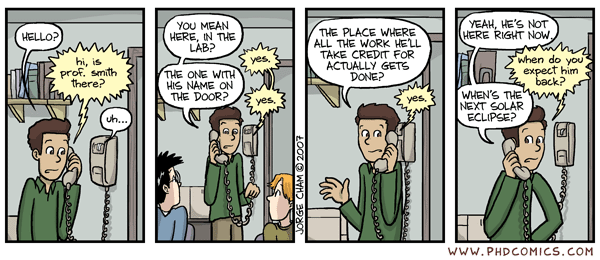I'm going to prototype a new series, which may spawn a separate blog, called Ask a Professor. The idea is that I get tons of questions about careers in science, and often I get the same questions from different people. So I figure I can broadcast the advice I can offer. Any question for which I can't give a good answer, I know lots of people who I can ask, and we can learn together in those cases.
This week's question is from Molly Peeples (UCLA), "What does a professor do all day? I think most postdocs realize it's some combo of research+teaching+advising+
 |
| phdcomics.com |
At the NSF Fellows symposium, Lynne gave an excellent talk about being a professional astronomer with a focus on how to manage one's time. In the talk, she mentioned that she kept a log of how she spent her time every single day for several months. Last year I asked Lynne for her log and she gave me permission to share it. However, I totally dropped the ball and the logsheet (in Excel format) lay unused until Molly's question. Finding it in my email archive was like finding a twenty-dolar bill in an old pair of jeans.
So without further delay, let's dig into the data! Lynne's data set spans Oct 8 through Dec 16. The number of hours per week is shown in the figure below, with the mean of 68.5 hours per week shown as a dashed line. That's a lotta hours per week! But keep in mind that this was when she was the department chair (the "Executive Officer" or EO, in Caltech parlance). Thus, this is probably skewed high, but it's still fairly instructive, especially since most full profs eventually serve as chair of the dept.
She also kept track of what she was spending her time doing:
teaching (formal) 12%
teaching (mentoring) 8%
teaching (research) 5%
total teaching: 25%
research (funded) 5%
research (unfunded) 14%
research (read/talk) 7%
total research: 26%
admin (chair) 16%
admin (dept) 7%
admin (campus) 1%
admin (national) 8%
total admin: 31%
email 7%
travel 6%
misc 4%
total other: 17%
So there you have it: raw, cold data. Of course, there are many caveats. This is just one data set for one prof. A particularly detailed one, for sure. But only a single sample. How does this compare to my breakdown of responsibilities? Let's take a look at how I spent my time two weeks ago (I was traveling last week), according to my Google Calendar and my memory.
The week of Jan 21 I worked every day of the week, including Saturday and Sunday (5 and 4 hours, respectively). On Mon, Tue, Thu I worked from 8am-noon, 12:30pm-5pm, and approximately 10-midnight, for 10.5 hours per day. On Wed and Fri I play basketball noon-1:30 and have lunch 1:30-2, so those days are shorter, only 8 and 9 hours each, respectively that week. That's a total of 57.5 hours, which is close to what I estimated in an earlier post.
The breakdown of activities, using slightly different categories, is: 18% teaching, 25% meetings (research and admin, on-camus and Skype/phone/telecon), 25% email/misc, 32% research (most of it in meetings with students/postdocs/collaborators, proof-reading, and my own 30-minute writing sessions). Looking at other weeks, the total time per week remains roughly constant, but the breakdown of what the time is spent on has a lot of variance. So my data point is less precise than Lynne's, but it agrees with a fairly even split among teaching, research, admin and email/misc. The caveat being that we work at Caltech, the land of the low teaching load.
Other profs: How do you spend your time? If you can lend some of your time, please take a look at last week's calendar and give us the breakdown in the comments.
Other questions? Send 'em to me in the comments, or via email/Facebook/Twitter.

Comments